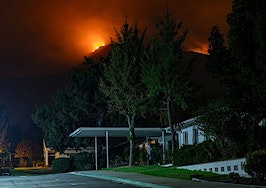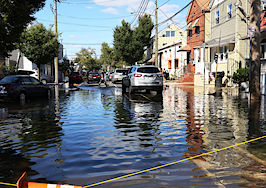A report funded by mortgage lenders warns that climate change is “likely to stretch the National Flood Insurance Program to the breaking point,” undermine home prices in vulnerable communities, and drive more homeowners to default on their mortgages.
“The Impact of Climate Change on Housing and Housing Finance,” published by the Mortgage Bankers Association’s Research Institute for Housing America (RIHA), calls for a concerted industry effort to assess and prepare for the risks posed by climate change, before they ripple through the housing system.
“Climate change will impact all governments, industries and individuals,” the report warns. “Housing and housing finance will not be spared.”
The report, by Stanford-trained economist Sean Becketti, rounds up consensus projections from scientists that global warming will cause sea levels to rise, and that other extreme weather events “will become more destructive and more frequent.”
“Increasingly devastating storms, excessive heat and wildfires, drought, and more all have the capacity to damage and destroy property,” the report said.
The U.S. housing and housing finance industries rely on a sophisticated system for distributing risk across multiple stakeholders including homeowners, insurers, mortgage lenders and investors, Fannie Mae and Freddie Mac, and the government. Climate change will place increasing stress on that system, creating financial risks for taxpayers, businesses and consumers, the report warned.
National Flood Insurance Program still deep in the red
The National Flood Insurance Program, which was pushed to its $30.5 billion borrowing limit in 2017 after hurricanes Katrina and Sandy, continues to insure properties today only because Congress forgave $16 billion of that debt. The program is currently $20.5 billion in debt, and just paying the interest on that debt will cost $10.3 billion by 2029, Becketti noted, citing a recent report by the Congressional Research Service.
“At some point, Congress may not be willing to forgive NFIP debt or to increase the NFIP debt ceiling without wholesale changes to the structure of the program,” Becketti predicted.
NFIP rates are going up on Oct. 1 to better account for risk, but subsidized premiums for owners of older homes are being phased out gradually. And because many of the Flood Insurance Rate Maps (FIRMs) that FEMA produces within Special Flood Hazard Areas (SFHAs) are out of date, many policies are mispriced, the report said.
“Given the consensus of increasing flood risk as a result of climate change, NFIP policies are likely to be priced too low to cover expected future flood risk,” the report warns. “These subsidies undercut the goal of discouraging further building in areas of high flood risk.”
An analysis by the First Street Foundation projects that average annual dollar losses due to flooding will increase 61 percent by 2051, to nearly $32.2 billion, and that rates on NFIP policies would have to be increased by 4.5 times if all properties at risk were insured.

Another academic study of two decades of property sales records concluded that because buyers aren’t factoring in the cost of fully insuring them, single-family homes located in floodplains are overvalued by $43.8 billion.
Becketti warns that even a “perfect insurance system” will be tested by climate change if premiums are prohibitively expensive, or if actuaries are no longer able to assess risk. And in places where flooding is no longer a risk, but a near certainty, insurance and other forms of risk sharing will no longer be practical.
“Some coastal communities are doomed. No sand dune engineering or flood wall construction will keep them from eventual inundation,” Becketti concluded.
One-year insurance policies can be renewed “for the foreseeable future,” but, “at some difficult-to-predict point, premiums will start to climb. Then companies will begin to limit coverage or decline to renew some policies. If the insurance commission mandates renewals, companies can still decline to write new policies, making properties unsalable.”
Mortgage defaults could pose risk to Fannie and Freddie
Although Fannie Mae and Freddie Mac are in theory protected from property damage by insurers, many homes that are not in officially designated floodplains may nevertheless be at risk.
Only about 4 percent of the U.S. population — 13 million people — lives in areas designated by the Federal Emergency Management Agency (FEMA) to be prone to flooding. Fannie and Freddie require flood insurance in those areas.
But three-quarters of FEMA flood maps are out of date, and one independent estimate puts the number of people living in floodplains at closer to 40 million people, the report noted. That would mean most people who live in floodplains aren’t required to get flood insurance when taking out a mortgage backed by Fannie and Freddie.
Whether they’re insured or not, some homeowners may decide to walk away from a home after a natural disaster, and default on a mortgage guaranteed by Fannie and Freddie.
“Despite the requirements for property and flood insurance, some victims of climate-change-related natural disasters will be unable or unwilling to continue paying their mortgages,” the report predicted. “The natural disaster may disrupt or eliminate their employment opportunities. The damage to their property may exceed the sum of their insurance coverage plus their other financial resources.”
“Whatever the reasons, natural disasters will produce increases in mortgage default,” Becketti wrote, citing a 2020 case study of loans that went into default after Hurricane Harvey.
New policy and legal challenges could prove costly
In addition to physical risks like hurricanes, flooding, droughts, and wildfires, the housing industry faces “transitional risks” in the form of new policy, legal, technological and market challenges imposed by policymakers as they try to limit the impacts of global warming.
“As government and regulatory policies on climate change evolve, firms may face higher costs and litigation risks,” the report warned. “Building codes may be expanded to include additional climate related requirements.”
Last year, for example, California became the first state in the nation to begin requiring rooftop solar panels on all new residential buildings with three stories or less.
If California or other states enact carbon taxes, builders may have to pay more for energy-intensive building materials — a cost that could be passed on to consumers. Builders and apartment owners might also be penalized for older HVAC systems, or be required to retrofit older buildings with more energy-efficient units.
In January, Fannie and Freddie’s regulator, the Federal Housing Finance Agency (FHFA), put out a public request for information to help it “better understand and address [Fannie and Freddie’s] exposure to climate and natural disaster risk.”
The request noted that, “As a prudential financial regulator, FHFA does not have expertise in climate science.”
The Mortgage Bankers Association submitted 16 pages of comments, including a recommendation that the FHFA “establish national standards for climate-related mortgage risks to avoid inconsistent regulation at the state level.”
“Governors of the nation’s largest states already have announced aggressive agendas to combat climate change, and New York State has gone a step further by establishing regulatory and examination expectations specifically for climate change risk mitigation for its state-licensed companies,” the MBA said. “Other states are likely to follow.”
The group also suggested that FHFA develop programs that would allow Fannie and Freddie to help low- and moderate-income borrowers who have trouble selling their homes because their flood insurance premiums are going up. Expanding the NFIP’s buyer program would be “a likely solution,” the MBA said.
Becketti — a former Freddie Mac chief economist — theorizes that Fannie and Freddie may shift some of the burden of assessing risk onto lenders.
“Today, lenders must guarantee that loans for homes in [FEMA designated flood zones] carry NFIP-approved flood insurance,” Becketti wrote. In the future, Fannie and Freddie “might require lenders to perform additional due diligence to determine the need for flood insurance. The lag in updating the FEMA flood maps may force lenders to incorporate additional sources of information on flood risk.”
The First Street Foundation provides dollar estimates of flood damage for individual residential homes through a flood risk assessment tool, Flood Factor, that’s integrated into real estate listing websites like realtor.com and Redfin.
Another step that FHFA could take would be to prohibit the mortgage giants from purchasing loans on homes with finished first levels too close to the base flood elevation. That would require lenders to obtain additional detailed information from appraisers, the report noted.





